Many people assume Thailand’s beaches are the jewel in the country’s crown.
And while many of them are undoubtedly glorious, we think that some of the Kingdom’s mountains are just as deserving – if not more so – of that title.
The saying goes that when it comes to Thailand, it’s beaches in the south and peaks in the north. Aside from a few exceptions, that’s largely the case – the North and Northeast region are brimming with mountain ranges as well as isolated elevations.
Doi Inthanon takes the crown for Thailand’s highest peak, at 2,565 metres above sea level, although we’re not convinced that it’s necessarily the nation’s most impressive. Nine other Thai mountains join it in the ‘above 2,000 metres’ club, and some can arguably beat it for better views and less tourist trampling.
Let’s take a look at the most stunning peaks Thailand has to offer…
1. Doi Chiang Dao
Chiang Mai
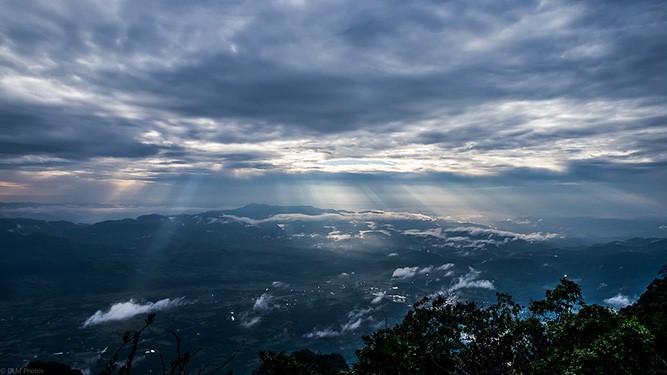
By Doug Mulvaney (CC BY 2.0 licence)
As Thailand’s third largest peak, Doi Chiang Dao doesn’t attract the same level of visitors as Doi Inthanon, but it does offer a comparatively much better hiking experience. Most climbers choose an overnight trek but fit and confident walkers are known to go up and down in a day.
This is the mountain to choose if you relish a good view. The peak itself is a limestone massif aged around 250 million years, and the trek and summit offer astonishing panoramas over the other mountains in the Daen Lao Range and over the Ao Salung Valley.
You are required to hire a guide to trek in Chiang Dao National Park, although some climbers are known to have avoided this by saying they intended on birding in the area.
Elevation: 2,175 metres
Park fee: ฿200 foreigners
2. Phu Soi Dao
Uttaradit
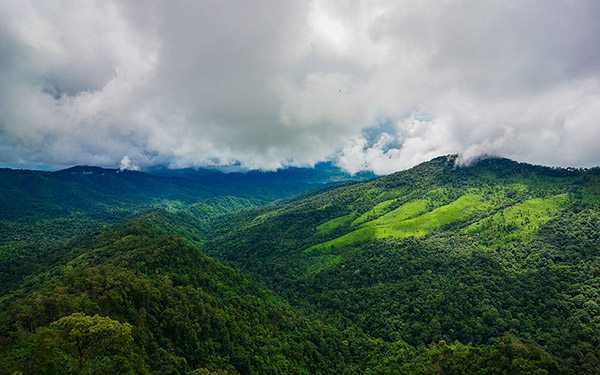
By 27Tula (Creative Commons)
Phu Soi Dao can be found in the Luang Prabang mountain range on the Thai-Laotian border, in the Phu Soi Dao National Park. It’s also known as ‘the mountain that cuts the stars’, and a stunning 5-tier waterfall of the same name really completes the picturesque scenery here.
The mountains in this range rise up from glorious virgin forest and a slew of rivers and streams, inhabited by a wide variety of wildlife. The panoramic views are sublime at the higher elevations.
It’s a 6.5 km hike to the summit which should take you approximately 6 hours. There’s very little by way of facilities so you will need to bring your own gear, tents and food.
Elevation: 2,120 metres
Park fee: ฿40
3. Doi Pha Hom Pok
Chiang Mai
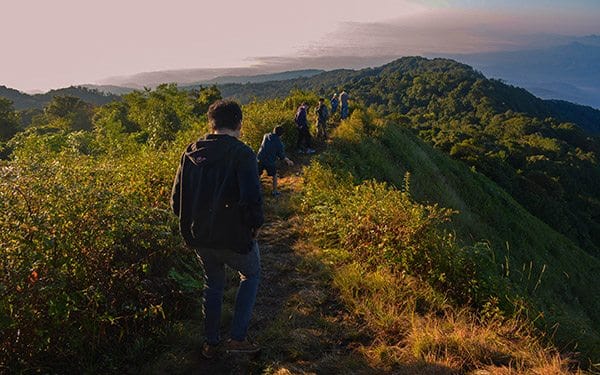
By Eartheart123 (Creative Commons)
This is the second tallest mountain in Thailand and is found in the Doi Pha Hom Pok National Park in Chiang Mai, right on the Burmese border.
Doi Pha Hom Pok is truly abundant in flora and fauna and the higher points of the peak are coated in thick forest. The mountain receives very little of the same tourist traffic that Doi Inthanon does, making for a rewarding and undisturbed trekking experience.
Treks to the summit usually begin pre-dawn at the Kiew Lom camp, and climbers should be prepared for some chilly temperatures at the top. You will require a guide to visit Doi Pha Hom Pok which can be hired from the National Park Office in nearby Fang.
Elevation: 2,285 metres
Park fee: ฿300 foreigners
4. Doi Tung
Chiang Rai
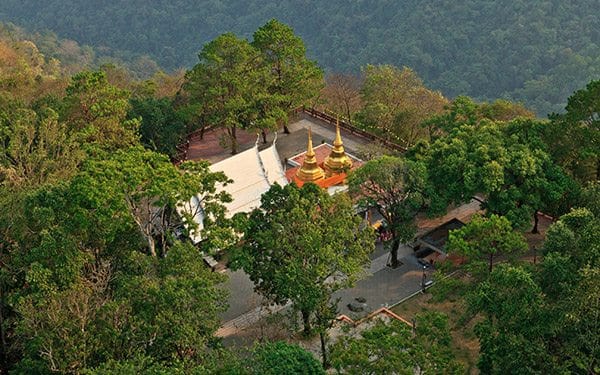
By Nick wichai (Creative Commons)
Doi Tung can be found in the Thai highlands at the Golden Triangle – the area where Thailand meets Myanmar and Laos. From the summit, you can enjoy spectacular views over Thailand and Myanmar.
Also at the summit is the Wat Phra That Doi Tung temple (pictured); it reportedly dates back to the tenth century and is a sacred spot for Buddhist pilgrims. Also on the mountain are the settlements of the Shan, Akha and Lahu hill tribes, as well as the Doi Tung Royal Villa – where the former Princess Mother Somdej Phra Srinagarindra used to live. The villa is now a museum and botanical gardens.
The energetic may like to try to the 100-kilometre route from Mae Fah Luang University to the summit and back on bicycles.
Elevation: 1,389 metres
Royal Villa fee: ฿80
5. Doi Inthanon
Chiang Mai
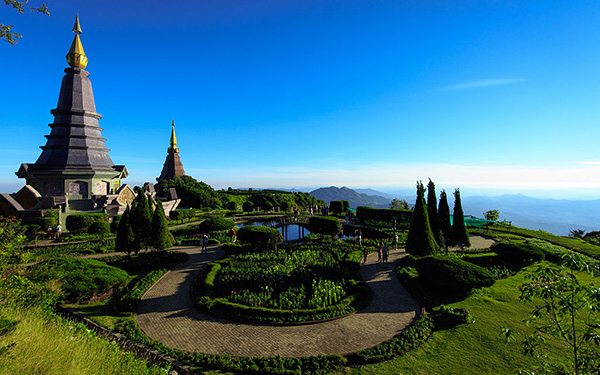
By Lester Mathias Andersson (Creative Commons)
Doi Inthanon – otherwise known as ‘The Roof of Thailand’ – is the Kingdom’s tallest peak and, consequently, one the most popular tourist attractions.
There’s not a huge amount of hiking on offer here: a paved road runs almost all the way to the summit.
The best part of Doi Inthanon is not the summit itself, which is just full of tourists queueing for a photo at ‘The Highest Spot In Thailand’ sign, but rather all there is to see on your ascent. From the Hmong hill tribes and incredible wildlife to the picturesque nature trail, waterfalls and royal chedis.
Elevation: 2,565 metres
Park fee: ฿200 foreigners
6. Khao Luang
Nakhon Si Thammarat
Khao Luang is southern Thailand’s tallest mountain, found within the Nakhon Si Thammarat Range and the Khao Luang National Park, which measures around 570 square kilometres.
Khao Luang is a granite mountain framed in evergreen forest valleys that hold over 300 species of orchids and 327 animal species – a great spot for the nature lovers.
The peak itself is generally always shrouded in fog and the national park is known for its prolonged rainy season from May to December. Try and go early in the year if you want the best views. Recommended treks from the centre of Nakhon Si Thammarat are for 3 days and 2 nights, and there are trekking companies operating in the area.
Elevation: 1,780 metres
Park fee: ฿200 for foreigners
7. Doi Ang Khang
Chiang Mai
Doi Ang Khang sits on the Thai-Burmese border and is well known as the origin site for where HM King Bhumibol opened a large agricultural research centre in 1969, which is still operating today.
Despite the area’s nickname of ‘Little Switzerland’, you’ll find that the landscape of Doi Ang Khang is much more richly lush and full of blossoming flowers and fruit. The Lahu and Palaung hill tribes inhabit the surrounding area while there are a number of small Chinese villages on the mountain’s ascent.
Most people choose to tackle the almost 25-km ascent by car, motorbike and – for the brave – bicycle, the latter of which you should be able to rent within the Agricultural Station. Try to catch sunrise or sunset at the brilliant Kiu Lom viewpoint.
Elevation: 1,928 metres
Agricultural Station fee: ฿50
8. Doi Nang Non
Chiang Rai
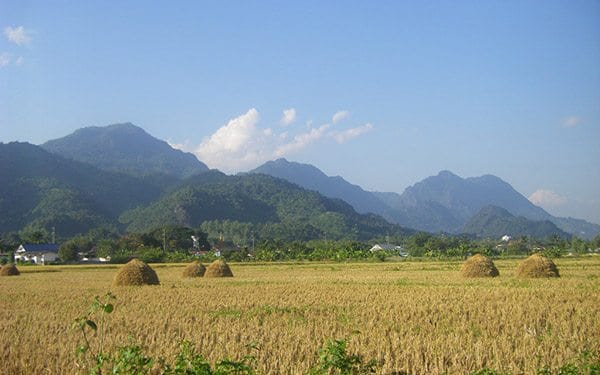
By mtspeth (Creative Commons)
Doi Nang Non is known as the ‘mountain of the sleeping lady’ in the Chiang Rai Thai highlands, so named as the outline of the mountain is reminiscent of a reclining woman with long hair, according to some sources.
The legend goes that a young, pregnant princess was abandoned by her lover so she went out to find him, walking until she could walk no more. Realising that she had been abandoned, utterly exhausted, she lay down and died of a broken heart – after death, her body grew to a huge shape and became covered in earth: hence, the shape of Doi Nang Non. Her unborn baby separated from her body and reputedly became the nearby peak of Doi Tung.
Doi Nang Non is dotted with caves, rivers and streams, and is great for exploring.
Elevation: 1,276 metres
Fee: unknown
9. Phu Kradueng
Loei
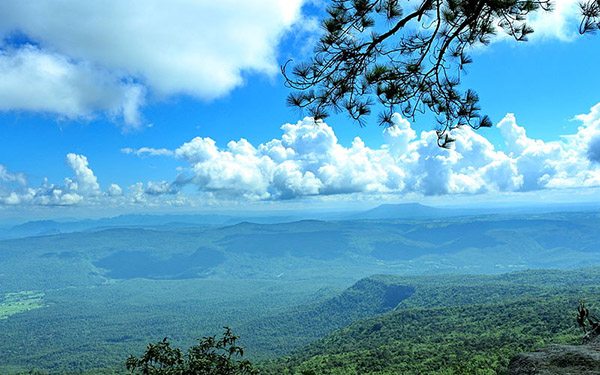
By Mmonthon (Creative Commons)
Located in beautiful Loei, sandstone mountain Phu Kradeung is heart-shaped from above and bell-shaped from the side. It boasts a flat plain on top and its sides are covered in mixed evergreen forest with grassland and pine trees at the higher elevations.
As you make you way to the summit, it’s likely you’ll come across some of the amazing wildlife of Phu Kradeung national park: including Asian elephants, macaques and an array of bird species. Camping is available on the mountain and tents can be rented if you haven’t brought your own.
Phu Kradeung is closed to visitors between July and September as it gets so slippery during rainy season. You’re likely to find a cool climate during the rest of the year although it’s best to expect a far bit of wind at the top.
Elevation: 1,316m metres
Park fee: ฿400 for foreigners
What’s your favourite Thai mountain?

